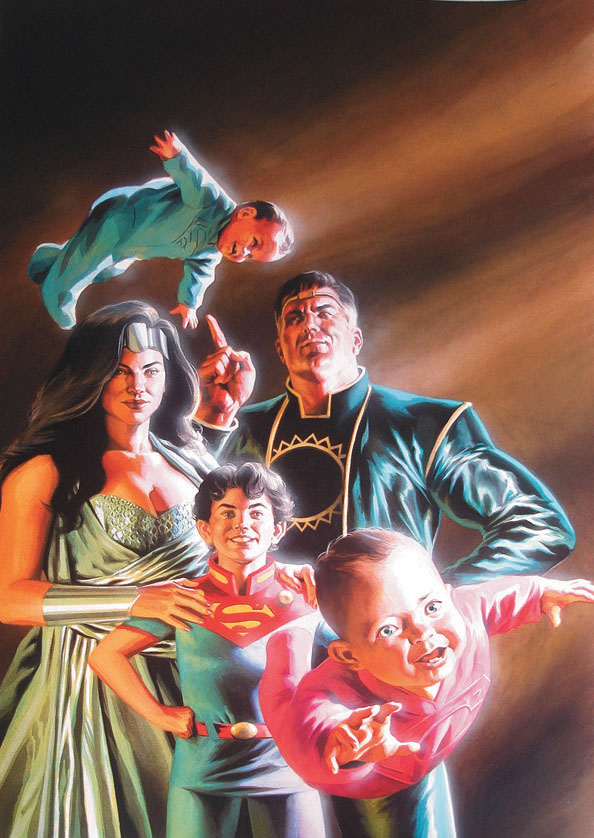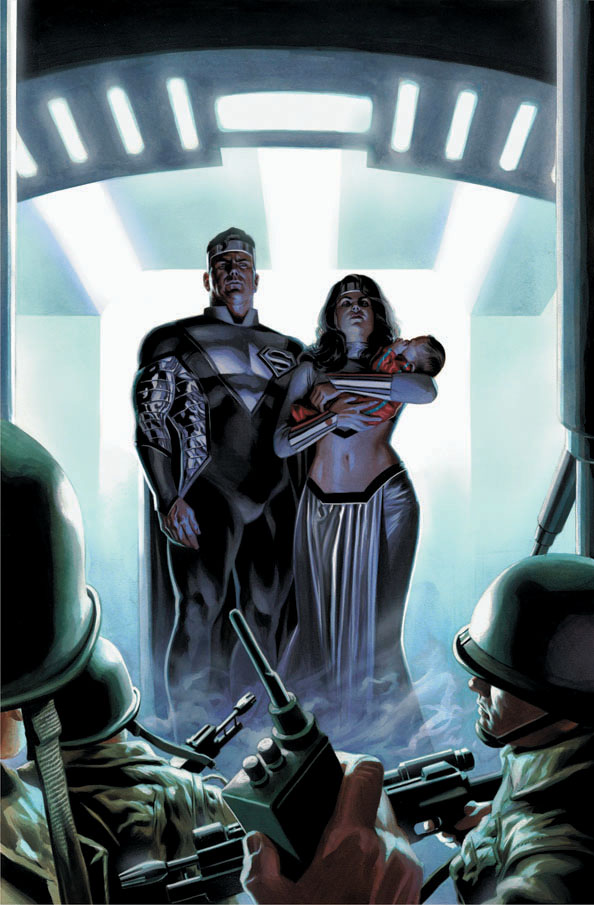Cary Bates began his comics career at the tender age of 13, by submitting ideas for covers to DC Comics in the early '60s, and started writing for the company at age 17 in 1965, developing lengthy and acclaimed runs on titles such as Superman, Superboy, Adventure Comics, and The Flash. He left comics in the early '90s, and is now making his return to DC with his first work for them in more than 15 years, with Superman: The Last Family Of Krypton, a 3-issue Elseworlds miniseries debuting in August. I spoke with Cary to learn more about the miniseries and how arrival of an complete Kryptonian family unit will change Superman's story.
Matt Adler: How did you initially come up with the idea for Superman: Last Family Of Krypton?
Cary Bates: Ever since I started reading comics I’ve always been a fan of so-called Imaginary Stories… the first script I ever sold to DC was an Imaginary Tale for World’s Finest back in 1967. When the basic nuts and bolts of this idea hit me, it seemed such a natural fit for Elseworlds. So natural, in fact, I had to verify for myself it had not already been done (the one partial exception being a long-forgotten 1962 Mort Weisinger story, The Super-Family From Krypton in Superboy #95). Once I combined the seminal “Last _____ of Krypton” tag with the word “Family” I had a gut feeling the project would take off.
MA: This is the first Elseworlds book in a long time; what made DC return to the concept for this series?
CB: You’d have to ask them, but I think the strength of the concept had a lot to do with it. As I understand it, one reason DC pulled the plug on the Elseworlds genre a few years back was the surplus of stories that basically plugged Superman or Batman into a vast assortment of historical eras, often without any particular internal nexus or logic. For myself, the most interesting Elseworlds were ‘parallel earth’ type projects that resonated strongly with Superman’s regular continuity … two striking examples being Kurt Busiek’s Superman: Secret Identity and Mark Millar’s Red Son.
MA: The cover to issue #1 shows that the arrival of the El family on Earth does not go unnoticed. Does an entire family unit of aliens arriving on Earth (implying the possibility of reproducing and multiplying) give the people of Earth greater cause for concern?
CB: That is definitely one of the main story threads in Book 1. At the outset at least, the way the Els are perceived has a definite Day the Earth Stood Still vibe. This was a fascinating theme to explore, not only because Jor-El and Lara were Superman’s parents but I couldn’t recall ever reading or seeing an alien arrival story where the “invaders’ were a young couple cradling an infant.
MA: Are you drawing on any past interpretations for your portrayal of Jor-El and Lara?
CB: Not really. Almost from page one , this story deals with a Jor-El and Lara as they’ve never been seen– in an entirely new context as super-powered citizens of Earth. And unlike the canon origin story, where we only got to see them in the last moments before Krypton’s destruction, this story chronicles their marriage over a period of some 30 years.
MA: Are we going to see the full range of Kal-El's growth and development, albeit with a more Kryptonian influence this time around?
CB: A resounding yes! To go into detail might spoil some of the surprises the series has in store, but suffice it to say you’ll be seeing a whole new dimension to Kal-El, which is the inevitable result of his birth parents being a constant presence in his life growing up. I wouldn’t be surprised if this story sets off a new rash of “nature vs. nurture” debates as it applies to the Els and the Kents.
MA: A key part of the Superman character is the persona of Clark Kent, which allows him some level of normalcy, not necessarily having to be super all of the time. Is that off the table with the Els' more public arrival?
CB: Although it might be logical to assume the Clark Kent persona would become superfluous if Jor-El and Lara are present during Kal-El’s childhood, this is not necessarily the case. How the whole Kent aspect of the Superman mythos presents itself in this parallel universe will be surprising and yet inevitable.
MA: Apart from physiology, what's the biggest difference between the Els and the Kents?
CB: Since the answer to this question informs one of the major themes that will dominate the course of all three books, I’ll defer to the story here.
 MA: Do you see any aspects of Kryptonian culture that are particularly difficult to assimilate into human culture?
MA: Do you see any aspects of Kryptonian culture that are particularly difficult to assimilate into human culture?
CB: I purposely avoided those aspects of Kryptonian culture (such as the various Guilds) that have recently been portrayed in detail in the New Krypton saga. It was my feeling that once they were living among us Jor-El and Lara would assume a “When in Rome….” approach, adapting or reintegrating aspects of their culture to make it more compatible with Earth’s.
MA: Do the Els' have concerns about the effect that they might have on humanity's development (for instance, the introduction of Kryptonian science and tech)?
CB: Yes and no. This concern manifests itself in several different forms throughout the course of the series, especially in Book 3.
MA: Will we see other DC heroes in the course of this series?
CB: Yes, there will be several cameos of other heroes… at least one of which will prove to have a major impact on this version of the DCU.
MA: Have you seen any of artist Renato Arlem's work yet?
CB: I’ve seen his artwork for all three books and I was just blown away. The pages are beautiful. His realistic approach to the characters and the action sequences, along with an uncanny ability to augment photo references for key backgrounds combine to give the whole series a “verisimilitude” all its own.
MA: What is it about the Superman mythos that makes it compelling enough to play around with in this way?
CB: The fact that he’s been a cultural icon for going on seven decades. Since the canon version of his origin is as well known as other timeless myths such as Robin Hood, Sherlock Holmes, the Lone Ranger, etc., it’s an irresistible challenge for a writer to take a legend so familiar to everyone and flip it inside out, so to speak. And the enduring popularity of Imaginary/Elseworld tales over the decades would seem to indicate readers enjoy reading them as much as we do writing them.
MA: Longtime readers know you had a career writing for DC for several decades, but you seemed to disappear from comics for more than 15 years, first returning in 2008 with True Believers at Marvel, and now this project at DC. What were you doing during your time away?
CB: I left New York in 1989 to serve as a story editor/staff writer on the Viacom Superboy TV series that the Salkinds were producing in Florida. That job led to my involvement with the proposed fifth Superman movie Superman Reborn (never filmed) and Christopher Columbus: The Discovery (released in 1992). After that, I moved to the west coast and became involved in TV animation for almost ten years, working on a wide range of shows… most notable Disney’s Gargoyles, and some not so well known, like Mummies, Starship Troopers, Max Steel, W.I.T.C.H., etc.
MA: What have been the biggest changes in the industry since then?
CB: You’re not just competing with other comics writers now but also TV and movie scribes like J. Michael Straczynski and Joss Whedon. The industry-wide overlap between mediums proves there’s no longer a stigma against comics like there used to be a few decades ago. Another difference is the internet. In the old days, feedback was relegated to the maybe 10 or 15 letters that would trickle in for weeks after a story was published. Now feedback is practically instantaneous, and seemingly never-ending. So, it’s a much more in-your-face business now.
MA: Have you been following any of DC's current Superman offerings?
CB: Up until the Last Family project entered my life, I had not been following regular Superman continuity on a regular basis, since I frankly never anticipated I would ever have any occasion to write the character again. But like the last Sean Connery James Bond movie said, “never say never again”.
MA: What other projects do you have in the works?
CB: Currently I’m working on a new series for DC about a super-hero duo I created. The book is intended to celebrate certain classic elements of the superhero mythos even as it turns the genre inside-out in ways not even Dr. Fredric Wertham could have imagined in his worst nightmare.
Matt Adler wishes to be the first to welcome our strange visitors from another planet.



Len Wein and Cary Bates back at DC? Can we get Elliot S! Maggin too? I love seeing these classic Bronze-era creators working in the industry again.
I like the idea. Who is doing the art?
Renato Arlem, who previously worked on Annihilation: Silver Surfer.
hmm reminds me too much of Kingdom Come for those of you who have finished it. Those two could very well be Kent and Diana.
Yup, they look a lot like Diana and Clark. Never before I notice that Lara had such a lovely belly though.
I was hoping Alex Ross do the art on this, but I guess Renato Arlem is not a bad choice.